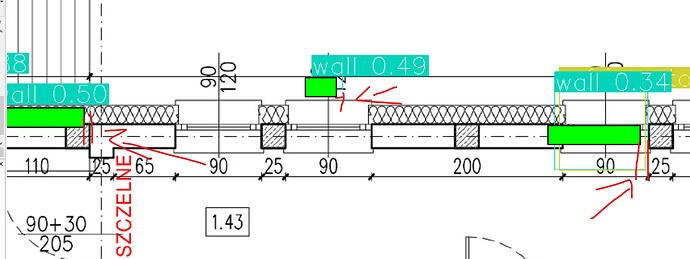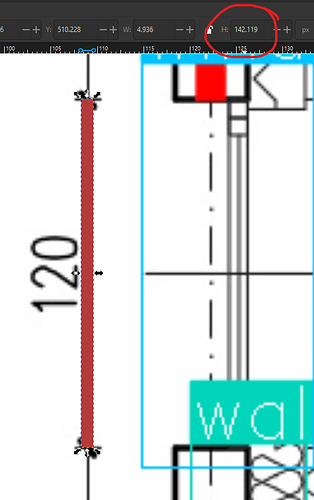Hi, i try to create pyrevit function to import my model detections into revit by creating walls by x/y min/max detection results. But i get walls shifts especially farther from the insertion point. I verified the calculations and all looks ok… Do you have any idea what could causing the variations?
120cm in draw is 142 pixels in image:
Here is the code:
## Imports
from Autodesk.Revit.UI.Selection import *
from Autodesk.Revit.DB import *
from pyrevit import forms
import csv
## Get revit model
doc = __revit__.ActiveUIDocument.Document
## def / class
### Change string to float in dict
def float_values(trips):
for key, value in trips.items():
try:
if key in ["ymin", "ymax", "xmin", "xmax"]:
trips[key] = float(value)
except ValueError:
continue
## Pick file with csv
try:
csv_file_path = forms.pick_file(title="Pick file with exported csv")
except:
forms.alert(title="Program Error", msg="You didn't pick csv file", exitscript=True)
## Ask for measured lenght in jpg image
lenght_real_centimeters = forms.ask_for_string(
default="Set value",
prompt="Write what is the real lenght of measure object in centimeters",
title="Real lenght",
)
lenght_pixels = forms.ask_for_string(
default="Set value",
prompt="Write what is the lenght of measure object in pixels",
title="Pixels lenght",
)
## Calculate scale
try:
scale = float(lenght_real_centimeters) / float(lenght_pixels)
except ValueError:
forms.alert(
title="Program Error",
msg="You wrote wrong lenght in centimeters or pixels (maybe you used letters?)",
exitscript=True,
)
except:
forms.alert(
title="Program Error",
msg="You wrote wrong lenght value in centimeters or pixels",
exitscript=True,
)
## Create walls
### Import csv
data_file = []
with open(csv_file_path) as csvfile:
data = csv.DictReader(csvfile, delimiter=",")
for row in data:
data_file.append(row)
### Change strings to float
for dict in data_file:
float_values(dict)
print(data_file)
## Create walls
### Collect levels and walls types
levels = (
FilteredElementCollector(doc)
.OfCategory(BuiltInCategory.OST_Levels)
.WhereElementIsNotElementType()
.ToElements()
)
walls = (
FilteredElementCollector(doc)
.OfCategory(BuiltInCategory.OST_Walls)
.WhereElementIsElementType()
.ToElements()
)
### Ask which wall(s) use
try:
walls_dict = {Element.Name.GetValue(x): x for x in walls}
selected_walls = forms.SelectFromList.show(
walls_dict.keys(),
title="Select walls to use",
multiselect=True,
button_name="Select walls to use",
)
if len(selected_walls) == 0:
raise Exception
except:
forms.alert(
title="Program Error",
msg="You canceled wall choosing or didn't pick anything",
exitscript=True,
)
walls_list = []
for wall_name in selected_walls:
walls_list.append((walls_dict[wall_name], walls_dict[wall_name].Width))
### Ask for level
try:
levels_dict = {x.Name: x for x in levels}
selected_level = forms.SelectFromList.show(
levels_dict.keys(),
title="Select level",
multiselect=False,
button_name="Select level",
)
if len(selected_level) == 0:
raise Exception
except:
forms.alert(
title="Program Error",
msg="You canceled level choosing or didn't pick anything",
exitscript=True,
)
### Ask for hight of import walls
height_of_walls = forms.ask_for_string(
default="Set value",
prompt="Write height of walls in centimeters",
title="Walls height",
)
try:
height_of_walls = float(height_of_walls) / 30.48
except:
forms.alert(
title="Program Error",
msg="You wrote wrong height in centimeters (maybe you used letters?)",
exitscript=True,
)
### Collect walls curves
curves_list = []
for dict in data_file:
a = dict["xmax"] - dict["xmin"]
b = abs(dict["ymax"] - dict["ymin"])
if (
a >= b
): # measure which side is longer this tell us which dimension is lenght and width
x1 = dict["xmin"]
x2 = dict["xmax"]
y1 = dict["ymin"] + (dict["ymax"] - dict["ymin"]) / 2
y2 = dict["ymin"] + (dict["ymax"] - dict["ymin"]) / 2
wall_thickness = b * scale
else:
x1 = dict["xmin"] + (dict["xmax"] - dict["xmin"]) / 2
x2 = dict["xmin"] + (dict["xmax"] - dict["xmin"]) / 2
y1 = dict["ymin"]
y2 = dict["ymax"]
wall_thickness = a * scale
# We must division by 30.48 because we need to translate centimeters to inches
point_1 = XYZ(
(x1 * scale) / 30.48,
(y1 * scale) / 30.48,
levels_dict[selected_level].Elevation,
)
point_2 = XYZ(
(x2 * scale) / 30.48,
(y2 * scale) / 30.48,
levels_dict[selected_level].Elevation,
)
# Create and collect revit curves with detected walls thickness
wall_line = Line.CreateBound(point_1, point_2)
print("p1 {} p2 {}".format(point_1.ToString, point_2.ToString))
curves_list.append((wall_line, wall_thickness / 30.48))
### Unzip picked walls with their thickness
walls, walls_thickness = map(list, zip(*walls_list))
### Start placing walls
t = Transaction(doc, "Walls from AECVision - PYLAB")
t.Start()
try:
#### Iterate throught lines
for line, thickness in curves_list:
#### Get closest wall thickness
wall_index = min(
range(len(walls_thickness)),
key=lambda i: abs(walls_thickness[i] - thickness),
)
#### Create wall
Wall.Create(
doc,
line,
walls[wall_index].Id,
levels_dict[selected_level].Id,
height_of_walls,
0,
False,
True,
)
except Exception as e:
forms.alert(title="Program Error", msg=e, exitscript=True)
t.Commit()
I upload the rvt model with scaled image and csv predictions.WeTransfer - Send Large Files & Share Photos Online - Up to 2GB Free
Thank you for help and suggestions!

